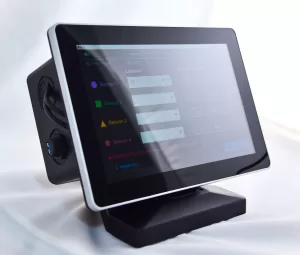BLOCKsynop® is a technology startup developing a product that will objectively measure the effectiveness of regional anesthesia. The team is led by Wayne Sternberger, PhD, and Robert S. Greenberg, MD, who had developed a benchtop version of the device using laboratory-grade equipment. They came to us to see how we could reduce the complexity and cost of the device for commercialization. We set out to create a proof of concept prototype.
From Laboratory to Prototype...
We wanted to tackle the riskiest part of the project at each step. Our first phase of work was to address the question of whether we could use a low-cost resource single-board computer to collect EMG electrode data and process it for display to an anesthesiologist. After exploring a LOT of options, we started with the Raspberry Pi 4 8GB combined with a data-acquisition Pi shield from Measurement Computing. We were pushing the specifications of these devices, but if we could determine it was feasible, a custom PCB solution could add processing speed and data sampling resolution. After a few revisions of the prototype software, we had a working solution that achieved the sampling and processing performance of laboratory-grade equipment.
Once the electronics and software were demonstrated, the next step was to design enclosures for the processing and sensing hardware and touch-screen display. The processor and sensor enclosures were first designed in CAD. Then, we used off-the-shelf boxes we CNC machined in-house to accommodate the connectors and display required for the unit. In a parallel effort, we refined the embedded software to process and display the sensor data in real-time. These initial proof of concept prototype devices were leveraged to begin clinical trials.
From Prototype to Medical Product!
With the initial prototypes in hand, the BLOCKsynop® team brought in a member of our network, a MedTech software specialist: TechSlice, to continue refining the app’s functionality and user interface. They also brought in a Human Factors Engineering specialist, DGCooley & Co., to design the UI and UX.
In the next phase, we assembled more processor units to connect with commercial off-the-shelf signal amplifiers. These new units incorporated updated hardware to interface with the amplifier, and new cables were fabricated to transfer the signals.
BLOCKsynop® returned to us for additional prototype units with several modifications based on feedback from clinicians and internal analysis, which we were able to quickly fabricate and deliver to them.
In the most recent phase, we created a new processor enclosure and cabling concept to accommodate a larger screen size and improve the signal quality from the sensors. We worked with BLOCKsynop® to source a new display and then designed new cabling and an enclosure to house the electronics inside. We were able to fabricate and assemble the cabling and enclosure in-house ourselves, thanks to our extensive fabrication workshop.
Moving forward, we’ll continue to support BLOCKsynop® as they move through clinical trials of their novel device. Stay tuned for more!



DESIGN FOCUS
- Embedded Software Development
- Low-Cost Computing
- EMG Data Collection
- Proof of Concept Prototyping
- Risk Mitigation
- Portability
FABRICATION
- Off-the-Shelf Hardware
- CAD Design
- Low-Cost Prototyping
- Cable Assemblies
- CNC Machined Enclosures


